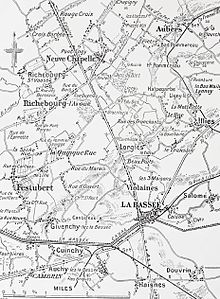Battle of La Bassée
| Battle of La Bassée | |||||||
|---|---|---|---|---|---|---|---|
| Part of the Race to the Sea on the Western Front (First World War) | |||||||
 Neuve Chapelle to La Bassée area, 1914 |
|||||||
|
|||||||
| Belligerents | |||||||
|
|
|
||||||
| Commanders and leaders | |||||||
|
|
Crown Prince Rupprecht | ||||||
| Strength | |||||||
|
II Corps 2nd Cavalry Brigade Lahore Division Detachments from the II (Conneau) Cavalry Corps |
6th Army | ||||||
| Casualties and losses | |||||||
| c. 15,000 | 6,000 (incomplete) | ||||||
|
|
|||||||
The Battle of La Bassée was fought by German and Franco-British forces in northern France in October 1914, during reciprocal attempts by the contending armies to envelop the northern flank of their opponent, which has been called the Race to the Sea. The German 6th Army took Lille before a British force could secure the town and the 4th Army attacked the exposed British flank further north at Ypres. The British were driven back and the German army occupied La Bassée and Neuve Chapelle. Around 15 October, the British recaptured Givenchy-lès-la-Bassée but failed to recover La Bassée.
German reinforcements arrived and regained the initiative, until the arrival of the Lahore Division, part of the Indian Corps. The British repulsed German attacks until early November, after which both sides concentrated their resources on the First Battle of Ypres and the battle at La Bassée was reduced to local operations. In late January and early February 1915, German and British troops conducted raids and local attacks in the Affairs of Cuinchy, which took place at Givenchy-lès-la-Bassée and just south of La Bassée Canal, leaving the front line little changed.
From 17 September – 17 October the belligerents had tried to turn the northern flank of their opponent. Joffre ordered the French Second Army to move to the north of the French Sixth Army, by moving from eastern France from 2–9 September and Falkenhayn ordered the German 6th Army to move from the German-French border to the northern flank on 17 September. Next day, French attacks north of the Aisne led to Falkenhayn to order the 6th Army to repulse the French and secure the flank. When the French advanced on 24 September, they met a German attack rather than an open flank and by 29 September, the Second Army had been reinforced to eight corps and extended north but was still opposed by German forces near Lille, rather than an open flank. The German 6th Army had also found that on arrival in the north, it was forced to oppose the French attack rather than advance around the flank and that the secondary objective of protecting the northern flank of the German armies in France, had become the main task.
...
Wikipedia

